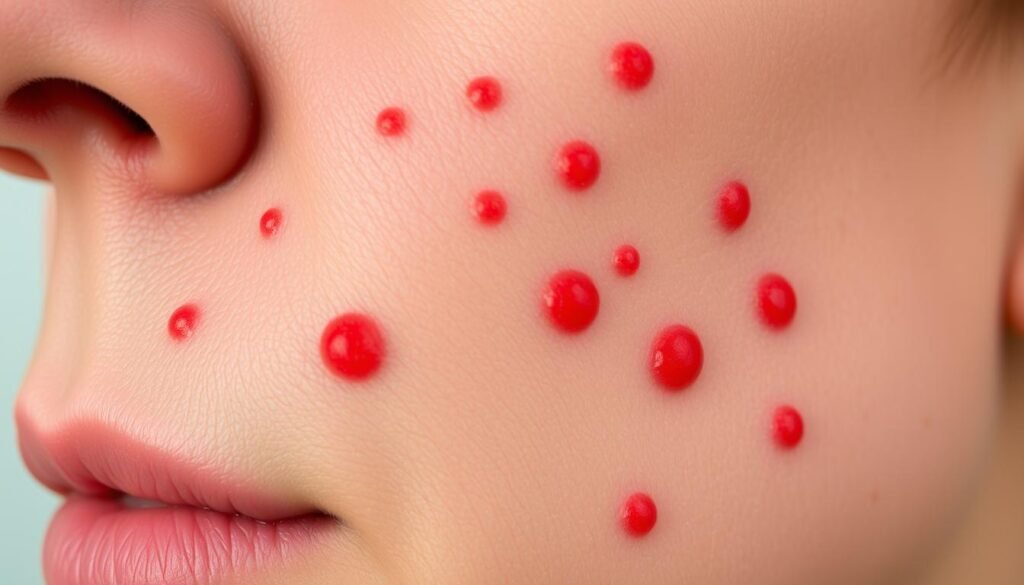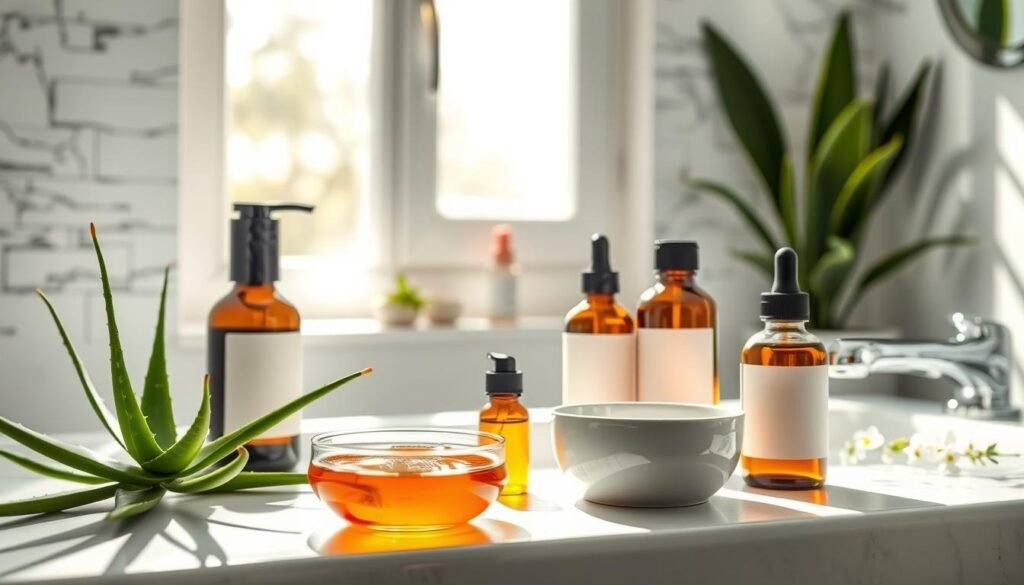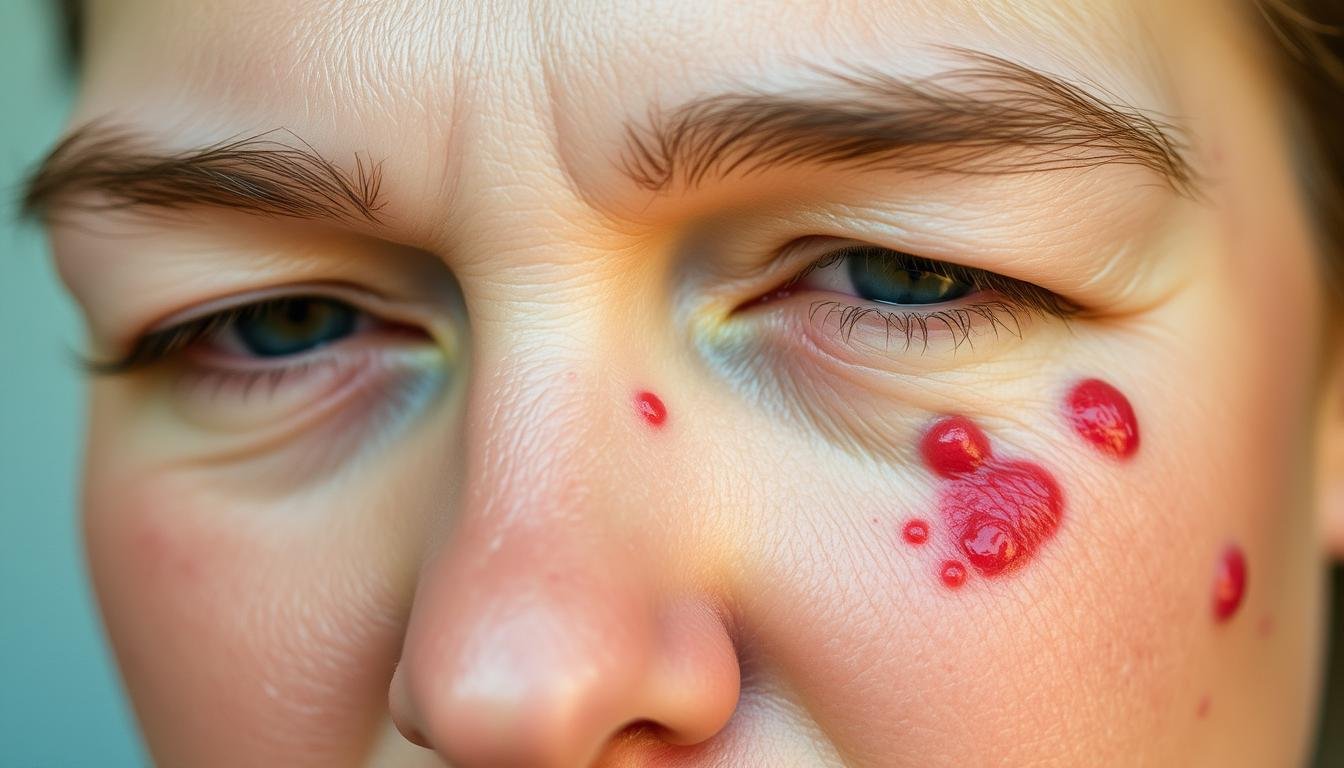I’ve always been fascinated by our skin’s unique features. Benign skin growths on the face are more than just medical facts. They are personal stories written on our skin.
Seeing new skin lesions can make us worried. But, most of these growths are harmless. They show the natural diversity of our skin. Our guide will help you understand these changes better.
As we get older, our skin changes. This is due to sun exposure, the environment, and aging itself. Moles and freckles tell us about our genes and life stories.
Key Takeaways
- Most facial skin growths are harmless and natural
- Skin changes occur due to aging, sun exposure, and genetics
- Understanding your skin can help reduce unnecessary worry
- Regular skin checks can help monitor any possible changes
- Professional dermatological consultation is recommended for persistent concerns
Understanding Facial Skin Growths and Their Impact
Skin growths are common and many people get them. Most are harmless and don’t harm your health. We’ll explore these interesting skin changes.
Definition and General Overview
Benign skin growths are non-cancerous changes in skin. They can come from age, genes, and the environment. Moles and keratosis are common on the face.
Why Facial Growths Occur
- Genetic inheritance
- Prolonged sun exposure
- Hormonal changes
- Aging processes
- Specific health conditions
Common Age Groups Affected
Skin growths get more common with age. About 33% of people see a doctor about them early on. Family doctors are 70% accurate, while dermatologists are 93% accurate.
“Understanding your skin’s changes is the first step toward maintaining skin health and peace of mind.”
Adults 30-60 years old often see new growths. The rate goes up a lot after 40.
Seborrheic Keratosis: The Most Common Facial Growth
Seborrheic keratoses are common skin growths that many people get as they age. They look like waxy, raised patches stuck to the skin.
Our research shows interesting facts about these growths:
- Over 80 million Americans develop seborrheic keratoses
- Most commonly appear after age 50
- Can range from very small to over 1 inch in diameter
- Typically brown or tan in color
Genetics play a big role in getting seborrheic keratoses. If your family has them, you might get them too. They don’t favor any gender but are more common in people with lighter skin.
“Seborrheic keratoses are like unexpected artistic signatures on our skin – unique, harmless, and telling a personal story of aging.” – Dermatology Insights
These growths are not contagious and don’t spread. They grow slowly, often first noticed in middle age.
| Characteristic | Description |
|---|---|
| Prevalence | Almost 100% of adults over 60 |
| Growth Pattern | Can increase in size and number over years |
| Risk Factors | Age, genetics, sun exposure |
Even though seborrheic keratoses are usually harmless, it’s smart to get your skin checked every year. This helps keep your skin healthy.
Dermatosis Papulosa Nigra in Different Skin Types
Dermatosis papulosa nigra (DPN) is a common skin issue that mainly affects people with darker skin. These growths on the face are small and have a unique look. They are also linked to genetics.
Looking into DPN shows us a lot about this skin condition. It affects many people from different ethnic backgrounds.
Characteristics and Appearance
DPN lesions are:
- Small, dark brown to black papules
- 1-5 mm in diameter
- Slightly raised
- Smooth or slightly textured
Population Most Affected
DPN is more common in certain groups:
| Population Group | Prevalence | Gender Distribution |
|---|---|---|
| African Americans | Up to 33% | 2:1 Female to Male Ratio |
| Hispanic Individuals | 10-75% | Higher Female Prevalence |
| Asian Populations | Significant Incidence | Similar Gender Pattern |
Treatment Options Available
There are many ways to treat these skin lesions:
- Cryotherapy
- Electrocautery
- Laser therapy
- Surgical excision
- Topical treatments
Seeing a dermatologist is key for a treatment plan that fits your skin.
Learning about DPN helps people make better choices for their skin health and looks.
Benign Skin Growths on Face: Essential Facts
Learning about benign skin growths on the face helps us take better care of our skin. Most facial skin tags and other benign growths are harmless. They usually don’t need immediate medical help.
Our research shows important facts about these common skin developments:
- Approximately 10-40% of adults have at least one mole
- 1 in 10 moles may change over time
- Some growths are more prevalent in specific population groups
Key statistical observations highlight interesting patterns in benign skin growths:
- Dermatofibromas are more common in women
- Keloids are more prevalent in individuals with darker skin tones
- Freckles frequently appear in people with blond or red hair
Not all skin growths are cause for concern, but understanding their characteristics is key for early detection.
When looking at benign skin growths on the face, dermatologists suggest using the ABCDE warning signs for melanoma:
- Asymmetry: Uneven mole halves
- Border: Irregular or ragged edges
- Color: Multiple color variations
- Diameter: Larger than a pencil eraser
- Evolving: Changes in appearance over time
While most facial skin tags and benign growths are harmless, it’s important to get a professional evaluation. This helps keep your skin healthy.
Moles and Nevi: Types and Characteristics
Our skin tells a unique story, and moles are fascinating chapters in that narrative. Moles are benign skin growths on our face and body. They show our individual genetic landscape. Knowing about these small skin features helps us watch our skin health.
Moles, or nevi, are common skin growths with different looks. They come from pigmented cells and can be flat or raised. They can also be smooth or textured.
Different Types of Facial Moles
- Congenital Nevi: Present at birth, occurring in 1-2% of newborns
- Acquired Moles: Developing after birth, often during childhood or early adulthood
- Blue Nevi: Distinctive blue-gray colored moles more common in Asian populations
- Spitz Nevi: Pink, raised bumps frequently seen in younger, fair-skinned individuals
When to Be Concerned About Changes
It’s important to watch moles for early signs of skin problems. Dermatologists suggest using the ABCDE rule to check moles:
| ABCDE Rule | What to Look For |
|---|---|
| Asymmetry | Uneven shape or sides |
| Border | Irregular or jagged edges |
| Color | Multiple colors or uneven pigmentation |
| Diameter | Larger than 6mm (eraser size) |
| Evolution | Changes in size, shape, or color over time |
Pro tip: Moles appearing after age 30 or showing the “ugly duckling sign” warrant professional evaluation.
Remember, while most moles are harmless, staying vigilant about changes can be a lifesaving practice.
Sebaceous Hyperplasia: Causes and Features
Sebaceous hyperplasia is a common, harmless skin growth found in about 1% of healthy adults. It shows up as small, flesh-colored to yellow bumps on the face. This can be a concern for those who worry about their skin’s look.
This condition is caused by a few main factors:
- Hormonal changes
- Getting older (most common after 40)
- Genetic predisposition
- Sun exposure
Sebaceous hyperplasia is marked by small bumps, usually 2-4 millimeters wide. It happens when sebaceous glands grow too big. Men are more likely to get it, often in their 80s.
“The presence of four or more sebaceous lobules around a hair follicle is a diagnostic indicator for sebaceous hyperplasia,” noted dermatological experts.
Our research shows interesting facts about this skin issue:
- Sebaceous gland activity peaks in the third decade of life
- Sebocytes’ turnover time is about one month
- It becomes more common in women after menopause
Even though sebaceous hyperplasia is usually harmless, it’s wise to watch for any changes. If you notice anything different, see a dermatologist. They can offer treatments like cryotherapy, laser therapy, or topical retinol, based on your skin type.
Skin Tags and Their Development
Facial skin tags are common and often worry people. They are small, soft, and flesh-colored. They can pop up without warning and bother many.
Knowing about facial skin tags helps people deal with them. Our research shows how they form and how common they are.
Common Locations on Face
Skin tags often show up where skin rubs together. On the face, they usually appear in certain spots:
- Neck creases
- Under the chin
- Around the eyelids
- Cheek folds
Risk Factors and Prevention
Several things can make facial skin tags more likely:
| Risk Factor | Impact on Skin Tag Development |
|---|---|
| Age | More prevalent in middle-aged and older adults |
| Weight | Higher risk in overweight individuals |
| Hormones | Pregnancy and diabetes can increase occurrence |
| Genetics | Family history may predispose individuals |
To lower the chance of getting facial skin tags, we suggest:
- Maintaining a healthy body weight
- Managing underlying health conditions
- Practicing good skincare
- Regular dermatological check-ups
While skin tags are generally harmless, any sudden changes in size, color, or appearance warrant professional medical evaluation.
Consultation with a dermatologist remains the most reliable approach for addressing facial skin tags and understanding individual risk factors.
Cherry Angiomas and Related Vascular Growths

Cherry angiomas are interesting skin growths found on faces and bodies. They are small, bright red, and very common, more so as we get older. These growths are usually 1 to 5 mm in size and look like tiny, dome-shaped bumps on the skin.
Our research shows some interesting facts about these skin formations:
- Approximately 75% of adults over 75 develop cherry angiomas
- Between 5% and 41% of individuals may start developing them in their 20s
- Cherry angiomas are equally distributed across all races and genders
Cherry angiomas usually start to appear in the third or fourth decade of life. They are usually not painful but can bleed if injured. Interestingly, they most commonly appear on the trunk, arms, and shoulders, not just on the face.
“Cherry angiomas are benign vascular proliferations that become increasingly prevalent with age” – Dermatological Research Journal
If you’re worried about these growths, there are many ways to treat them. Options include electrocauterization, shave excision, cryotherapy, and pulsed dye laser (PDL) treatments. You might need one to three sessions, depending on the number and size of your lesions.
Even though cherry angiomas are usually harmless, seeing a dermatologist is a good idea if you have many. Learning about these growths helps us understand them better.
Treatment Options for Facial Skin Growths
Understanding how to treat benign skin growths on the face is key. Our guide covers the best ways to handle various skin lesions. We focus on precision and care in each approach.
Medical Procedures for Skin Lesions
There are many ways to remove facial skin growths. Here are some common ones:
- Shave excision for mole removal
- Cryotherapy for skin tags and keratoses
- Electrodessication for sebaceous hyperplasia
- Surgical extraction for deeper skin lesions
Procedure Details and Recovery
Each treatment has its own benefits and things to consider. Knowing the details helps patients make the best choice.
| Procedure | Duration | Recovery Time |
|---|---|---|
| Cryotherapy | 15-20 minutes | 1-2 weeks |
| Surgical Excision | 20-30 minutes | 5-7 days |
| Electrodessication | 10-15 minutes | 7-10 days |
Post-Treatment Care
Aftercare is vital for healing. Patients should:
- Keep the treated area clean and dry
- Avoid direct sunlight
- Follow the doctor’s wound care instructions
- Watch for signs of infection
“Early intervention and professional assessment can prevent complications with skin growths.” – Dermatology Experts
Seeing a dermatologist is the best way to get personalized treatment for skin lesions and facial growths.
Prevention and Risk Factors
It’s important to know what can cause benign skin growths on the face. Our skin faces many environmental and genetic challenges. These can lead to skin lesions.
Several key factors contribute to the formation of facial skin growths:
- Genetic predisposition
- Age-related changes
- Sun exposure
- Hormonal fluctuations
- Skin type and complexion
About 1 in 5 people will develop some form of skin growth in their lifetime. Environmental factors are a big part of this.
“Prevention is always better than cure when it comes to skin health.”
We suggest taking steps to lower your risk:
- Use broad-spectrum sunscreen with SPF 30 or higher
- Avoid peak sun hours (10 am to 4 pm)
- Wear protective clothing
- Regular skin examinations
| Risk Factor | Impact on Skin Lesions |
|---|---|
| Sun Exposure | High risk of developing age spots |
| Age | Increased likelihood of skin growths after 45 |
| Genetics | Predisposition to certain skin conditions |
Knowing these risk factors helps us protect our skin. We can lower the chance of getting benign skin growths on the face.
When to Seek Medical Attention
Knowing when to get help for benign skin growths on your face is key to keeping your skin healthy. While most growths are harmless, some changes can mean trouble and need a doctor’s check-up.
Our skin is always changing, and about 25% of people get skin growths like moles. Spotting warning signs is vital to keep you healthy.
Critical Warning Signs to Watch
- Rapid growth of moles or skin growths
- Changes in color or surface texture
- Irregular borders or asymmetrical appearance
- Persistent itching or bleeding
- Pain around the skin growth
Professional Evaluation Process
Dermatologists suggest using the ABCDE rule for skin growths: Look for Asymmetry, Border irregularity, Color variations, Diameter, and Evolving characteristics.
| Evaluation Criteria | Recommended Action |
|---|---|
| Sudden appearance | Schedule dermatologist consultation |
| Size larger than 6mm | Professional examination needed |
| Multiple color changes | Immediate medical assessment |
With 1 in 5 people getting skin cancer in their lifetime, catching it early is critical. A board-certified dermatologist can check your skin and suggest the right treatment for benign growths on your face.
Natural and Home Care Methods

Managing benign skin growths on the face needs a mix of medical advice and home care. While home methods can’t replace doctor visits, they can help keep your skin healthy. This might make keratosis and other growths less noticeable.
We suggest a skincare routine that keeps your skin in top shape:
- Gentle daily cleansing with non-irritating products
- Consistent sun protection using broad-spectrum sunscreen
- Maintaining optimal skin hydration
Natural remedies can offer some support for benign skin growths. Research in dermatology shows some methods might help manage skin issues:
- Tea tree oil for its antimicrobial benefits
- Aloe vera to reduce skin inflammation
- Witch hazel for soothing properties
Remember: Natural methods should complement, not replace, professional medical guidance.
If you have keratosis or other benign growths, be patient and keep up with your skincare. Watch for changes, protect your skin from the sun, and see dermatologists often. This can help manage these common facial issues well.
Living with Facial Skin Growths
Dealing with benign skin growths on the face can be tough. Our self-esteem often links to how we look. Skin lesions can make us feel less confident.
But, most skin growths are harmless. This news can calm those worried about their skin.
- Accepting your unique skin characteristics
- Seeking support from healthcare professionals
- Understanding the medical nature of skin growths
- Practicing positive self-talk
*Knowledge is power when it comes to understanding your skin.*
The way skin growths affect us varies. Some feel shy, while others love their unique look. About 50% of adults have skin tags, showing how common they are.
| Age Group | Skin Growth Prevalence |
|---|---|
| 30-45 years | Moderate occurrence |
| 45-60 years | High occurrence |
| 60+ years | Very high occurrence |
Dermatologists suggest yearly skin checks to watch for changes. The American Academy of Dermatology stresses the need to know your skin and get help when needed.
Most facial skin growths are normal and don’t mean serious health issues. Loving your skin can boost your confidence and calm your mind.
Conclusion
We’ve looked closely at benign skin growths on the face. These are common skin issues. Studies show that 92% of people have at least one growth.
These growths can be different, like seborrheic keratoses or skin tags. Each one has its own look and health effects.
It’s key to watch for these growths and get a doctor’s opinion. Research shows that age, gender, and health can affect them. For example, seborrheic keratoses are very common in people over 70.
We suggest regular skin checks and talking to a doctor. Our dermatology practice is in Florida, covering places like Orlando and The Villages. Call us at +1(352) 565-7575 for help with your skin.
We’re dedicated to giving you the best care. By knowing more and acting early, you can take care of your skin. And you can do it with the help of experts.




